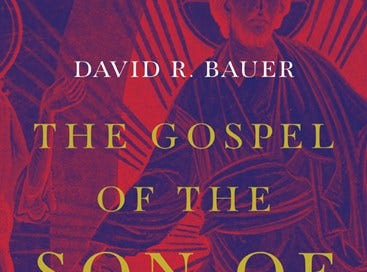Matthew: The Gospel of the Son of God
David R. Bower
The Gospel of the Son of God: An Introduction to Matthew
Downers Grove, IL: InterVasity, 2019.
Reviewed by Scott Harrower, Ridley College.
What Christology does Matthew’s Gospel commend to its readers? How does a narrative such as a Gospel communicate the theology that inheres within it? These questions are addressed by David R. Bower’s The Gospel of the Son of God: An Introduction to Matthew.
Bauer’s work is focused on the theology (especially the Christology) that is generated by the narratival structure, concerns, and characters of Matthew’s Gospel. It is a work that self-consciously identifies as a form of narrative criticism, and is a literary-theological commentary on Matthew’s Gospel (40-41). The fundamental idea is that it studies Matthew inductively, and hence is driven by those concerns that he believes are intrinsic to the document itself (41). Bauer’s methodological assumption is that “the very nature of the Gospel of Matthew should provide us with the framework or mode of its study (4).” His approach is narrative criticism because it “has rightly taken the fundamental literary character of our Gospels seriously and has developed effective processes to analyse the various literary features of the text so as to lead readers to a fuller and at times more accurate interpretation of the Gospels” (39). Another way he characterizes his work is “a close reading of the text (which is informed by careful exegetical and historical analysis) that will lead to conclusions regarding its theology” (137).
For Bauer, it is important that his method is not merely “one method alongside others, but rather a holistic, synthetic approach that seeks to hear the message of the Gospel of Matthew on its own terms” by means of selectively employing “the most optimal ... elements from every legitimate method (41).” By means of his “inductive approach” Bauer is trying to counter the “methodological smorgasbord” approach to studying the theology of the Gospels. He aims at a “consensual way” of reading Matthew, “a way of reading the book that all, or at least most, interpreters can agree on” (40). This inductive, narrative-theological method is trying to offer to all readers the theology that emerges from Matthew’s Gospel in such a way that it may be discussed widely rather than by specialists in one method alone. Bauer’s inductive method aims at demonstrating that Matthew’s author and the key characters in the narrative have evaluative points of view, or series of theological stances, to do with Jesus’s person, work and relationship to God: he “evaluative point of view” is “the beliefs and values of the implied author and the various characters as he presents them” (38). These theological views are commended to the reader for evaluation to the end of them making theological judgements of their own (38). Because his methodology is consensual, then it should lead to consensual theological claims, claims that are thus valid and normative for Christian, which in turn drive discipleship (309-327, the theme of the final chapter of the work).
In light of this approach, he states his “contention that, in terms of form, the Gospel of Matthew is literary; in terms of content it is theological; and in terms of context it is historical. Therefore, the focus of our study ought to be literary, theological and historical” (4). This three-fold interest sets up the structure of the commentary. The first part deals with historical context of the Gospels, the second with how its nature and composition develops its themes and meaning. The third section deals with theological claims that are generated by the narrative’s concerns.
To this reviewer’s mind, the work is a success, and it serves as an excellent commentary as well as introduction to the theological interpretation of Scripture.




